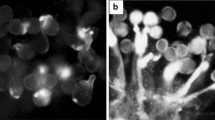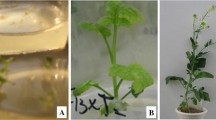Summary
An SLG gene derived from the S-locus and encoding and S-locus-specific glycoprotein of Brassica campestris L. was introduced via Agrobacterium-mediated transformation into B. oleracea L. A self-incompatible hybrid and another with partial self-compatibility were used as recipients. The transgenic plants were altered in their pollen-stigma interaction and were fully compatible upon self-pollination. Reciprocal crosses between the transgenic plants and untransformed control plants indicated that the stigma reaction was changed in one recipient strain while the pollen reaction was altered in the other. Due to interspecific incompatibility, we could not demonstrate whether or not the introduced SLG gene confers a new allelic specificity in the transgenic plants. Our results show that the introduced SLG gene perturbs the self-incompatibility phenotype of stigma and pollen.
Similar content being viewed by others
References
Bateman AJ (1955) Self-incompatibility systems in angiosperms. III. Cruciferae. Heredity 9:52–68
Bevan M (1984) Binary Agrobacterium vectors for plant transformation. Nucleic Acids Res 12:8711–8721
Dwyer KG, Balent MA, Nasrallah JB, Nasrallah ME (1991) DNA sequences of self-incompatibility genes from Brassica campestris and B. oleracea: polymorphism predating speciation. Plant Molec. Biol. (in press)
Fry J, Barnason A, Horsch RB (1987) Transformation of Brassica napus with Agrobacterium tumefaciens-based vectors. Plant Cell Rep 6:321–325
Hodgkin T (1978) The inheritance of partial self-compatibility in Brassica oleracea L.: results from a half diallel homozygous for a highly recessive S-allele. Theor Appl Genet 53:81–87
Hood EE, Helmer GL, Fraley RT, Chilton MD (1986) The hypervirulence of Agrobacterium tumefaciens A281 is encoded in a region of pTiBo542 outside of T-DNA. J Bacteriol 168:1291–1301
Kandasamy MK, Paolillo DJ, Faraday CD, Nasrallah JB, Nasrallah ME (1989) The S-locus-specific glycoproteins of Brassica accumulate in the cell wall of developing stigma papillae. Dev Biol 134:462–472
Kandasamy MK, Dwyer KG, Paolillo DJ, Doney RC, Nasrallah JB, Nasrallah ME (1990) Brassica S-proteins accumulate in the intercellular matrix along the path of pollen tubes in transgenic tobacco pistils. Plant Cell 2:39–49
Kho YO, Baer J (1968) Observing pollen tubes by means of fluorescence. Euphytica 17:298–302
Koncz C, Schell J (1986) The promoter of TL-DNA gene 5 controls the tissue-specific expression of chimaeric genes carried by a novel type of Agrobacterium binary vector. Mol Gen Genet 204:383–396
Krol AR van der, Lenting PE, Veenstra J, Meer IM van der, Koes RE, Gerats AGM, Mol JNM, Stuitje AR (1988) An antisense chalcone synthase gene in transgenic plants inhibits flower pigmentation. Nature 333:866–869
Krol AR van der, Mur LA, Beld M, Mol JNM, Stuitje AR (1990) Flavonoid genes in Petunia: addition of a limited number of gene copies may lead to a suppression of gene expression. Plant Cell 2:291–299
Matzke MA, Primig M, Trnovsky J, Matzke AJM (1989) Re- versible methylation and inactivation of marker genes in sequentially transformed tobacco plants. EMBO J 8:643–649
Moore HM, Nasrallah JB (1990) A Brassica self-incompatibility gene is expressed in the stylar transmitting tissue of transgenic tobacco. Plant Cell 2:29–38
Napoli C, Lemieux C, Jorgensen R (1990) Introduction of a chimeric chalcone synthase gene into petunia results in reversible co-suppression of homologous genes in trans. Plant Cell 2:279–289
Nasrallah ME (1974) Genetic control of quantitative variation in self-incompatibility proteins detected by immunodiffusion. Genetics 76:45–50
Nasrallah ME (1989) The genetics of self-incompatibility reactions in Brassica and the effects of suppressor genes. In: Lord E, Bernier G (eds) Plant reproduction: from floral induction to pollination, vol. 1. The American Society of Plant Physiologists Symposium Series, Rockville, Maryland, pp 146–155
Nasrallah JB, Nasrallah ME (1989) The molecular genetics of self-incompatibility in Brassica. Annu Rev Genet 23:121–139
Nasrallah JB, Doney RC, Nasrallah ME (1985a) Biosynthesis of glycoproteins involved in the pollen-stigma interaction of incompatibility in developing flowers of Brassica oleracea L. Planta 165:100–107
Nasrallah JB, Kao TH, Goldberg ML, Nasrallah ME (1985b) A cDNA clone encoding an S-locus-specific glycoprotein from Brassica oleracea. Nature 318:263–267
Nasrallah JB, Yu SM, Nasrallah ME (1988) Self-incompatibility genes of Brassica oleracea: expression, isolation, and structure. Proc Natl Acad Sci USA 85:5551–5555
de Nettancourt D (1977) Incompatibility in angiosperms. (Monographs on theoretical and applied genetics, vol 3) Springer, Berlin Heidelberg New York, pp 1–230
Rogers SO, Bendich AJ (1988) Extraction of DNA from plant tissues. In: Gelvin SB, Schilperoort RA (eds) Plant molecular biology manual. Kluwer, Dordrecht Boston London, A6:1–10
Rogers SG, Klee H, Horsch RB, Fraley RT (1988) Use of cointegrating Ti plasmid vectors. In: Gelvin SB, Schilperoort RA (eds) Plant molecular biology manual. Kluwer, Dordrecht Boston London, A2:1–12
Rothstein SJ, Lahners KN, Lotstein RJ, Carozzi NB, Jayne SM, Rice DA (1987) Promoter cassetes, antibiotic-resistance genes, and vectors for plant transformation. Gene 53:153–161
Smith CJS, Watson CF, Ray J, Bird CR, Morris PC, Schuch W, Grierson D (1988) Antisense RNA inhibition of polygalacturonase gene expression in transgenic tomatoes. Nature 334:724–726
Takayama S, Isogai A, Tsukamoto C, Ueda Y, Hinata K, Okazaki K, Suzuki A (1987) Sequences of S-glycoproteins, products of the Brassica campestris self-incompatibility locus. Nature 326:102–104
Thompson KF, Taylor JP (1966) Nonlinear dominance relationships between S-alleles. Heredity 21:345–362
Thorsness MK, Kandasamy MK, Nasrallah ME, Nasrallah JB (1991) The Brassica S-locus gene promoter targets toxic gene expression and cell death to the pistil and pollen of transgenic Nicotiana. Dev. Biol. 143:173–184
Toriyama K, Hinata K (1988) Diploid somatic-hybrid plants regenerated from rice cultivars. Theor Appl Genet 76:665–668
Toriyama K, Thorsness MK, Nasrallah JB, Nasrallah ME (1991) A Brassica S-locus gene promoter is expressed sporophytically in tapetal cells of the anther of transgenic Arabidopsis. Dev. Biol. 143:427–431
Umbach AL, Lalonde BA, Kandasamy MK, Nasrallah JB, Nasrallah ME (1990) Immunodetection of protein glycoforms encoded by two independent genes of the self-incompatibility multigene family of Brassica. Plant Physiol 93:739–747
Author information
Authors and Affiliations
Additional information
Communicated by H. F. Linskens
Rights and permissions
About this article
Cite this article
Toriyama, K., Stein, J.C., Nasrallah, M.E. et al. Transformation of Brassica oleracea with an S-locus gene from B. campestris changes the self-incompatibility phenotype. Theoret. Appl. Genetics 81, 769–776 (1991). https://doi.org/10.1007/BF00224988
Received:
Accepted:
Issue Date:
DOI: https://doi.org/10.1007/BF00224988




